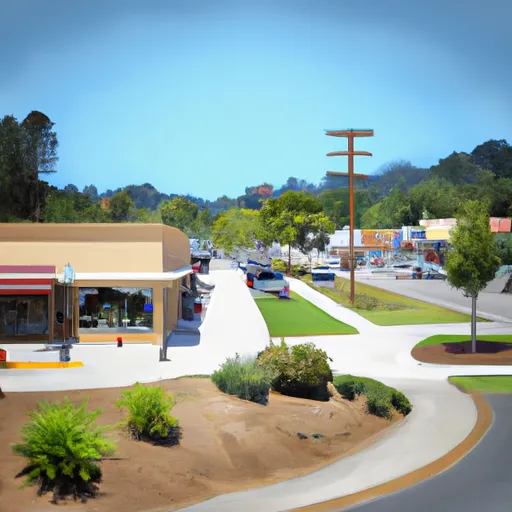-
 Snoflo Premium
Snoflo Premium
Get unlimited access to all our content
With no Ad interruptions! - Start Your Free Trial Login with existing account
Clipper-Mills
Eden Index
Climate
7.7
•
Recreation
7.1
•
Community
•
Safeguard
5.6/10

Clipper-Mills is a small unincorporated community located in Butte County, California, with a population of around 142 residents. The area has a Mediterranean climate with hot, dry summers and mild, wet winters. The community is surrounded by dense pine forests and is home to many lakes and rivers, including the Oroville Reservoir. The hydrology constituents in the area are affected by the Feather River watershed, which provides water to many local water systems. Outdoor recreation opportunities in Clipper-Mills include fishing, boating, hiking, and camping. The nearby Lake Oroville State Recreation Area is a popular destination for outdoor enthusiasts with its multiple campgrounds, hiking trails, and water activities.
What is the Eden Index?
The Snoflo Eden Index serves as a comprehensive rating system for regions, evaluating their desirability through a holistic assessment of climate health, outdoor recreation opportunities, and natural disaster risk, acknowledging the profound impact of these factors on livability and well-being.
Climate Health Indicator (CHI): 7.7
Clipper-Mills receives approximately
2063mm of rain per year,
with humidity levels near 63%
and air temperatures averaging around
12°C.
Clipper-Mills has a plant hardyness factor of
8, meaning
plants and agriculture in this region tend to thrive here all year round.
By considering the ideal temperature range, reliable water supplies, clean air, and stable seasonal rain or snowpacks, the Climate Health Indicator (CHI) underscores the significance of a healthy climate as the foundation for quality living.
A healthy climate is paramount for ensuring a high quality of life and livability in a region, fostering both physical well-being and environmental harmony. This can be characterized by ideal temperatures, reliable access to water supplies, clean air, and consistent seasonal rain or snowpacks.
Weather Forecast
Streamflow Conditions
Lower Sacramento
Area Rivers
Lower Sacramento
Snowpack Depths
Lower Sacramento
Reservoir Storage Capacity
Lower Sacramento
Groundwater Levels
Recreational Opportunity Index (ROI): 7.1
The Recreational Opportunity Index (ROI) recognizes the value of outdoor recreational options, such as parks, hiking trails, camping sites, and fishing spots, while acknowledging that climate plays a pivotal role in ensuring the comfort and consistency of these experiences.
Access to outdoor recreational opportunities, encompassing activities such as parks, hiking, camping, and fishing, is crucial for overall well-being, and the climate plays a pivotal role in enabling and enhancing these experiences, ensuring that individuals can engage in nature-based activities comfortably and consistently.
Camping Areas
| Campground | Campsites | Reservations | Toilets | Showers | Elevation |
|---|---|---|---|---|---|
| Fiddle Creek | 18 | 2,281 ft | |||
| Bullards Lakeshore | 60 | 2,082 ft | |||
| Dark Day | 15 | 1,955 ft | |||
| South Yuba | 16 | 2,621 ft | |||
| Frenchy Point | 9 | 1,958 ft | |||
| Nevada County Fairgrounds | None | 2,455 ft | |||
| Garden Point | 20 | 1,945 ft | |||
| Indian Valley | 22 | 2,329 ft | |||
| Cal Ida | 19 | 2,679 ft | |||
| Carlton Flat | 26 | 2,272 ft |
Nearby Ski Areas
Catastrophe Safeguard Index (CSI):
The Catastrophe Safeguard Index (CSI) recognizes that natural disaster risk, encompassing floods, fires, hurricanes, and tornadoes, can drastically affect safety and the overall appeal of an area.
The level of natural disaster risk in a region significantly affects safety and the overall livability, with climate change amplifying these risks by potentially increasing the frequency and intensity of events like floods, fires, hurricanes, and tornadoes, thereby posing substantial challenges to community resilience and well-being.
Community Resilience Indicator (CRI):
The Community Resilience Indicator (CRI) recognizes that education, healthcare, and socioeconomics are crucial to the well-being of a region. The CRI acknowledges the profound impact of these elements on residents' overall quality of life. By evaluating educational resources, healthcare accessibility, and economic inclusivity, the index captures the essential aspects that contribute to a thriving community, fostering resident satisfaction, equity, and social cohesion.

